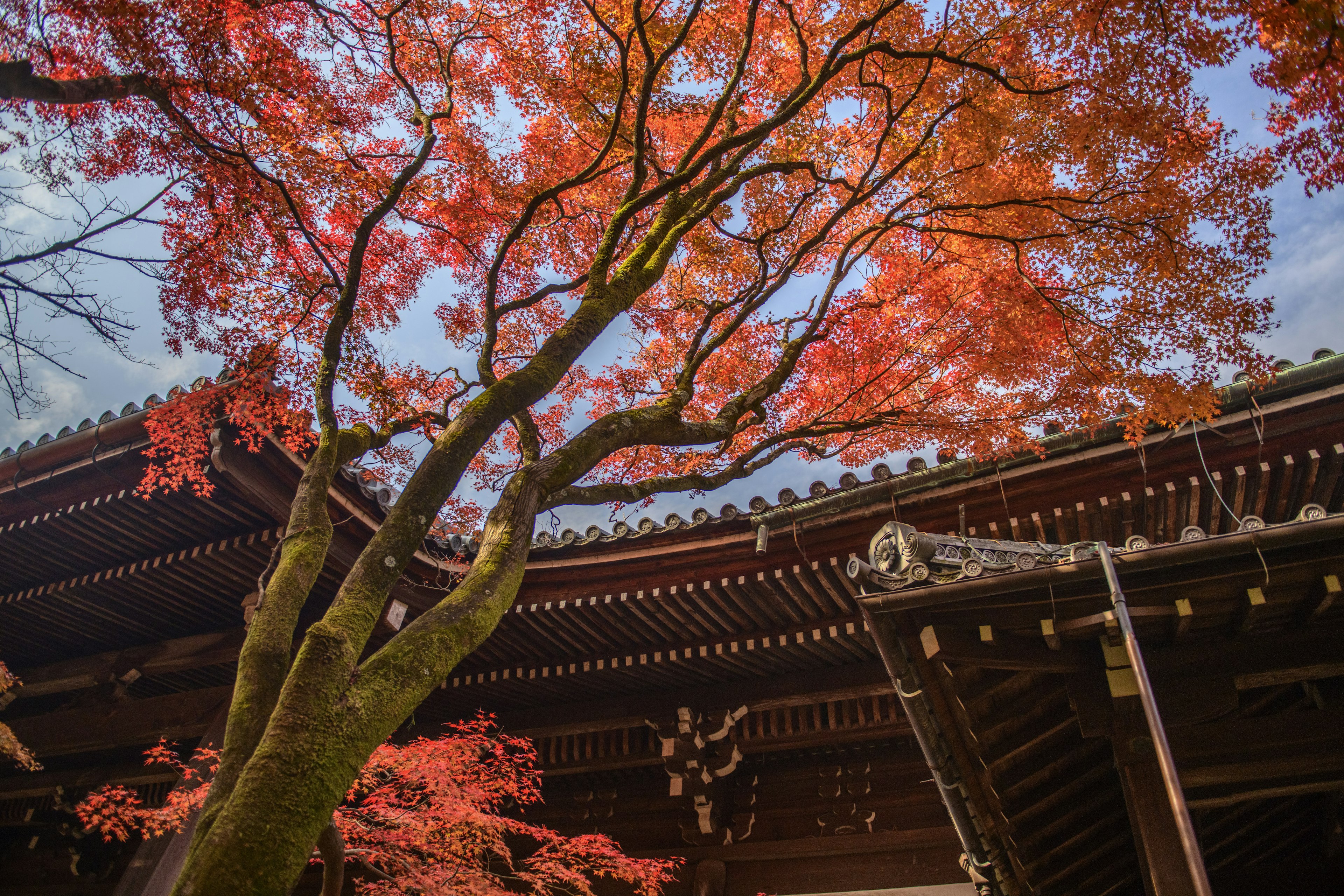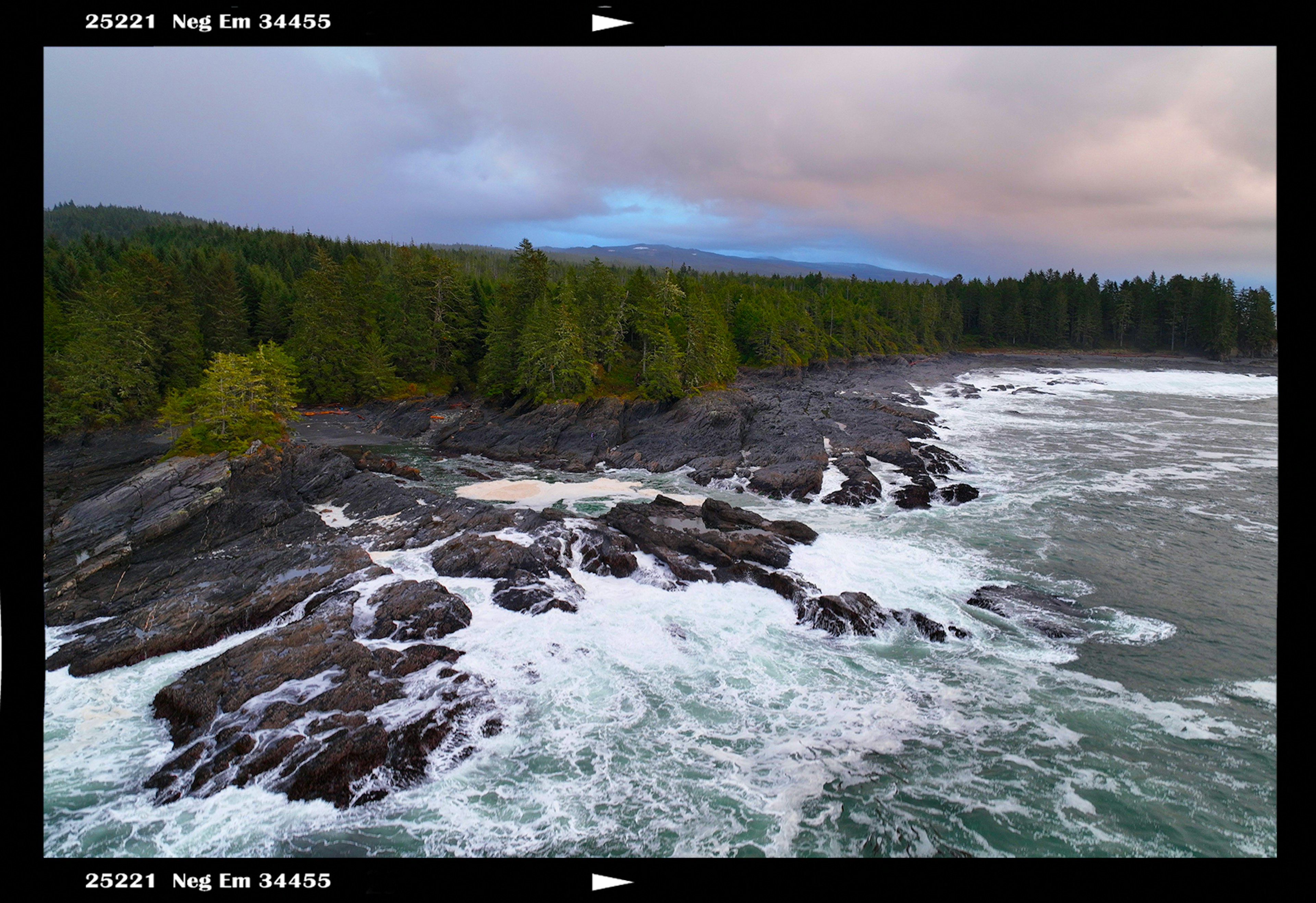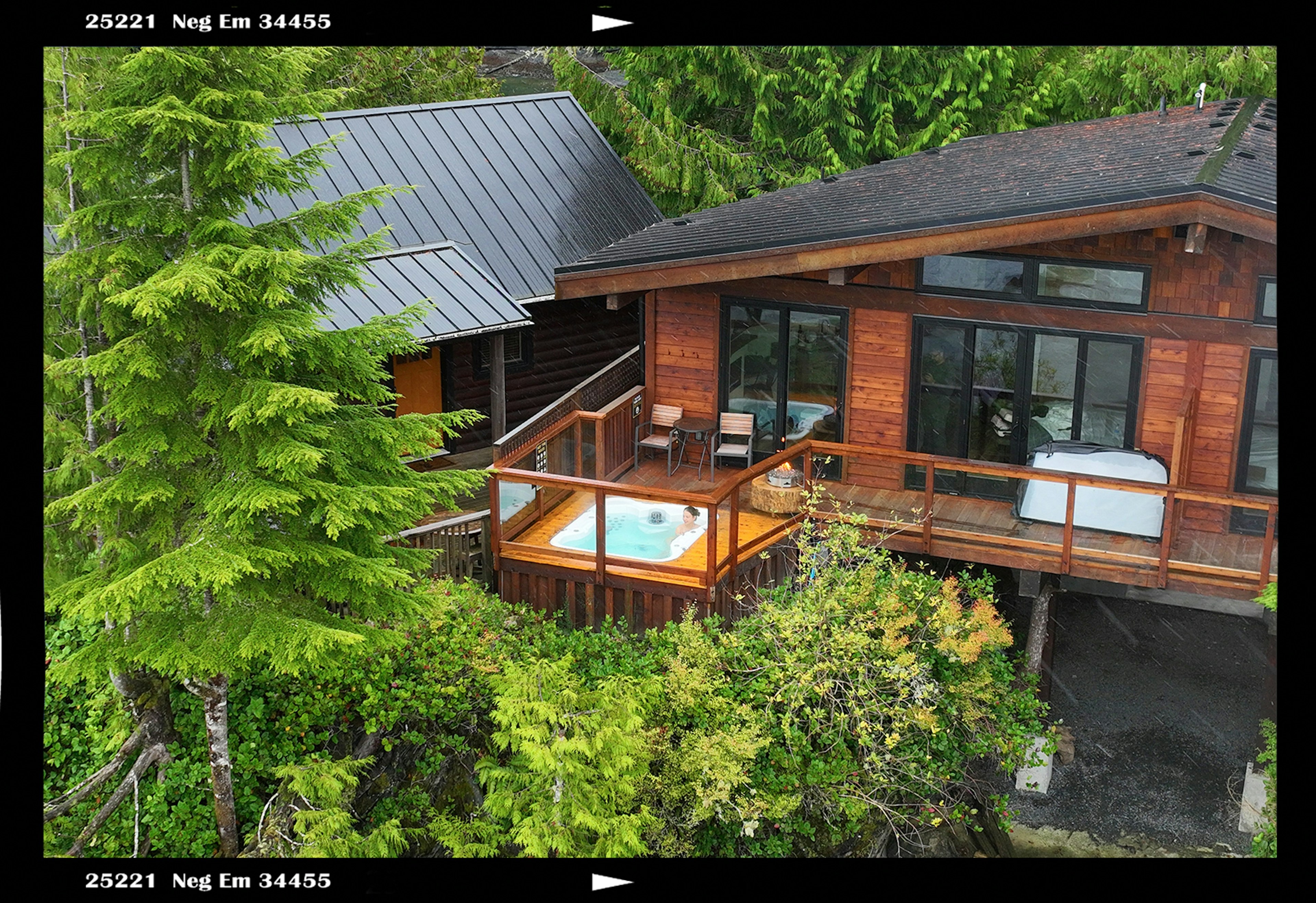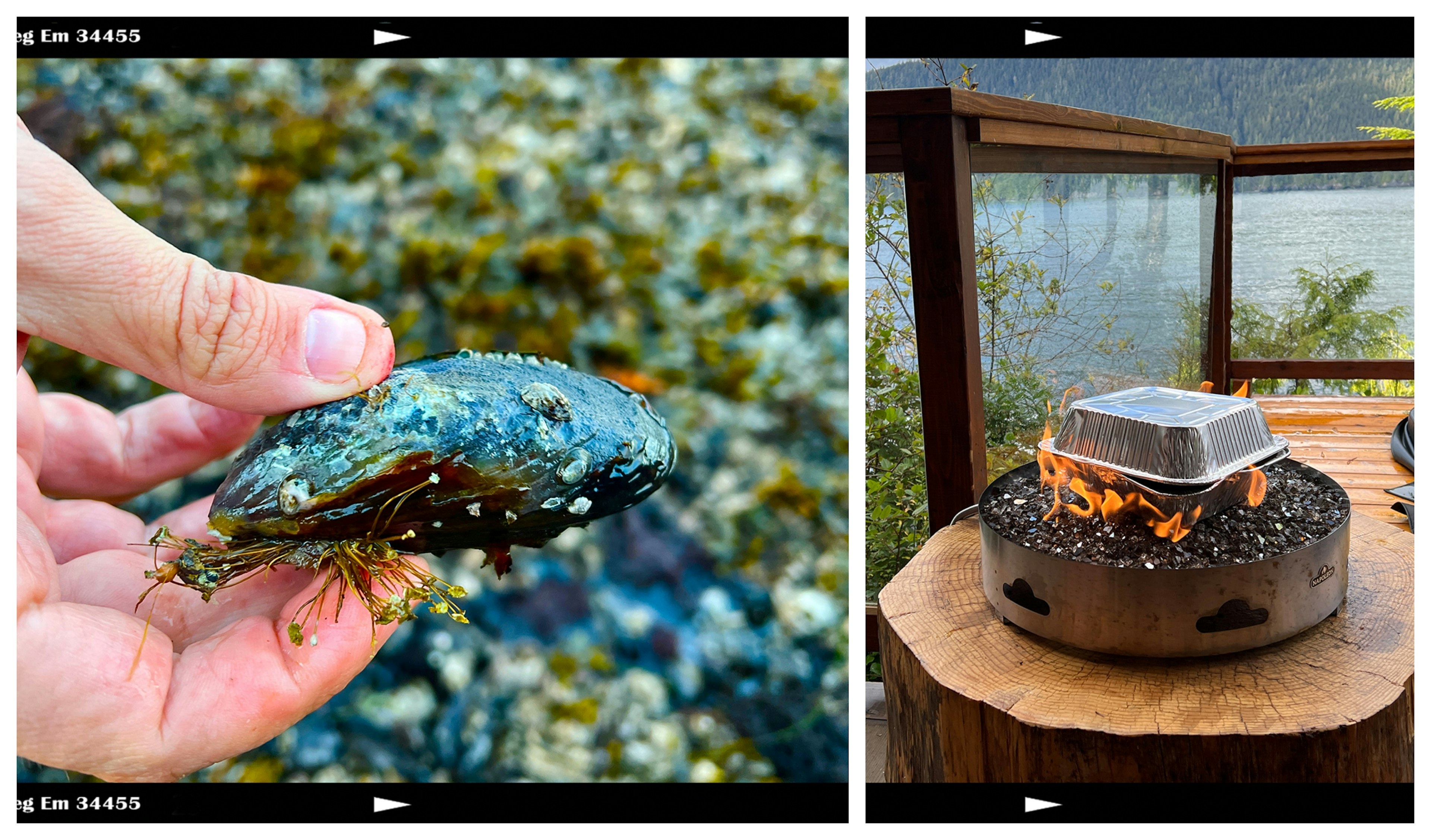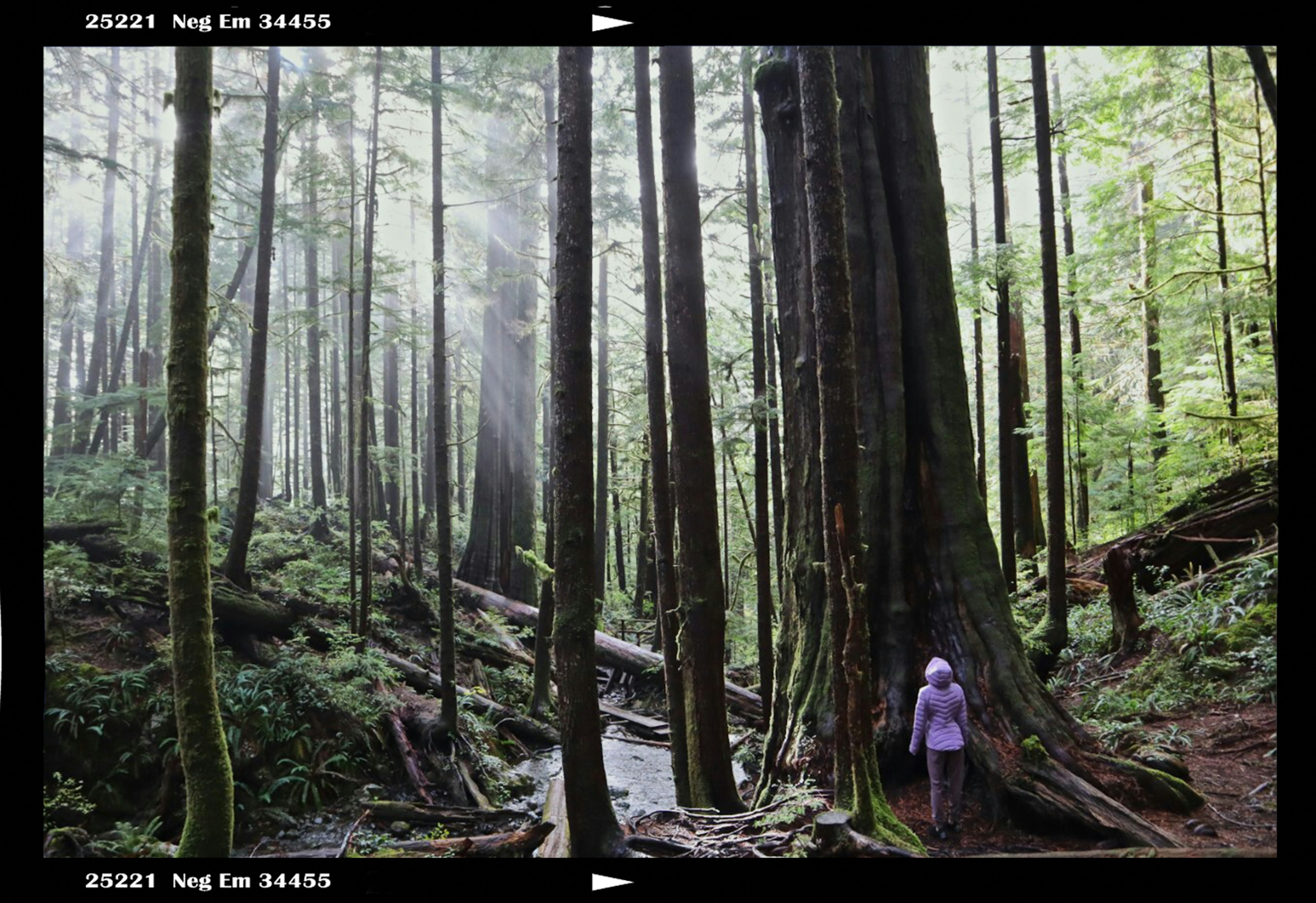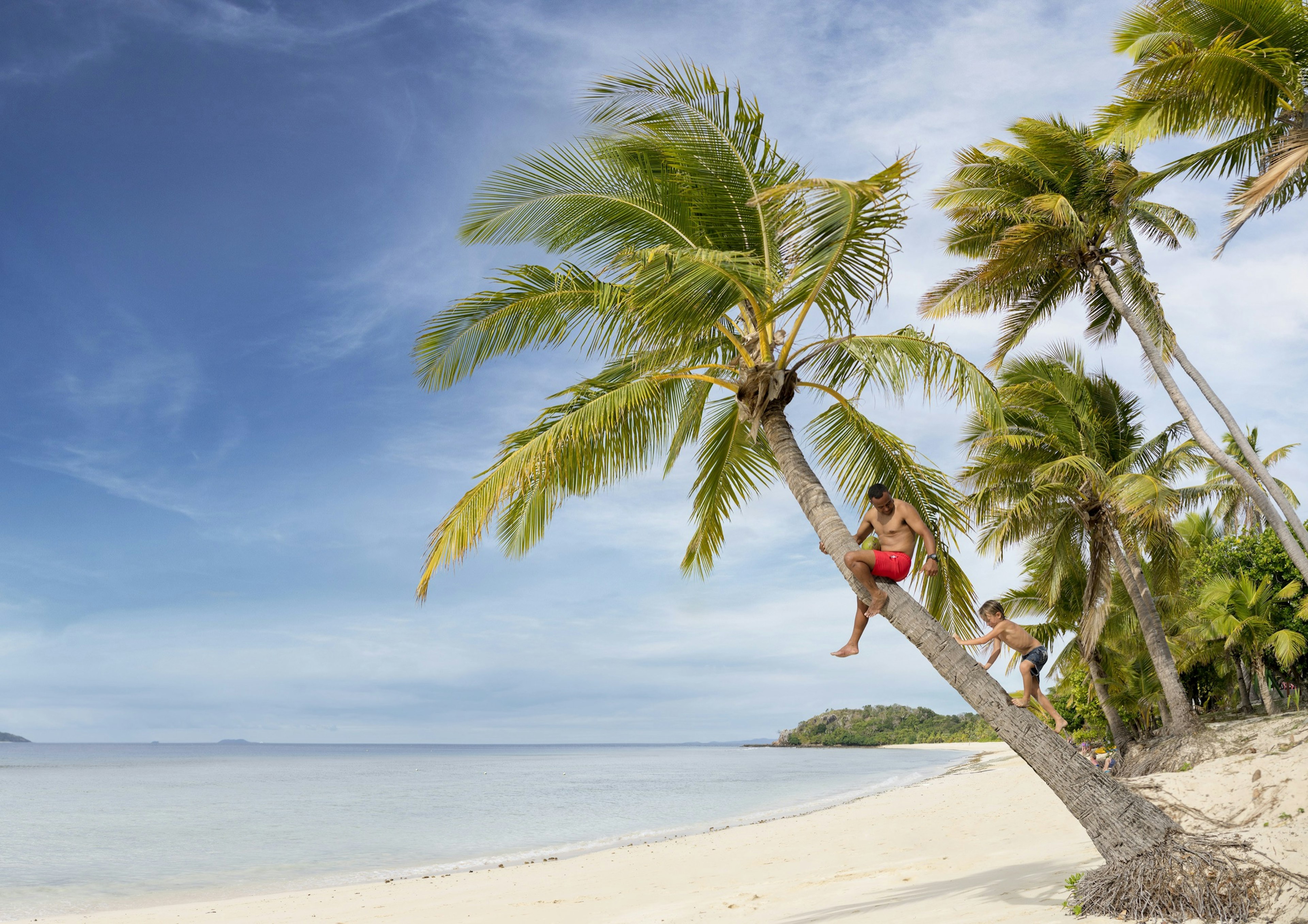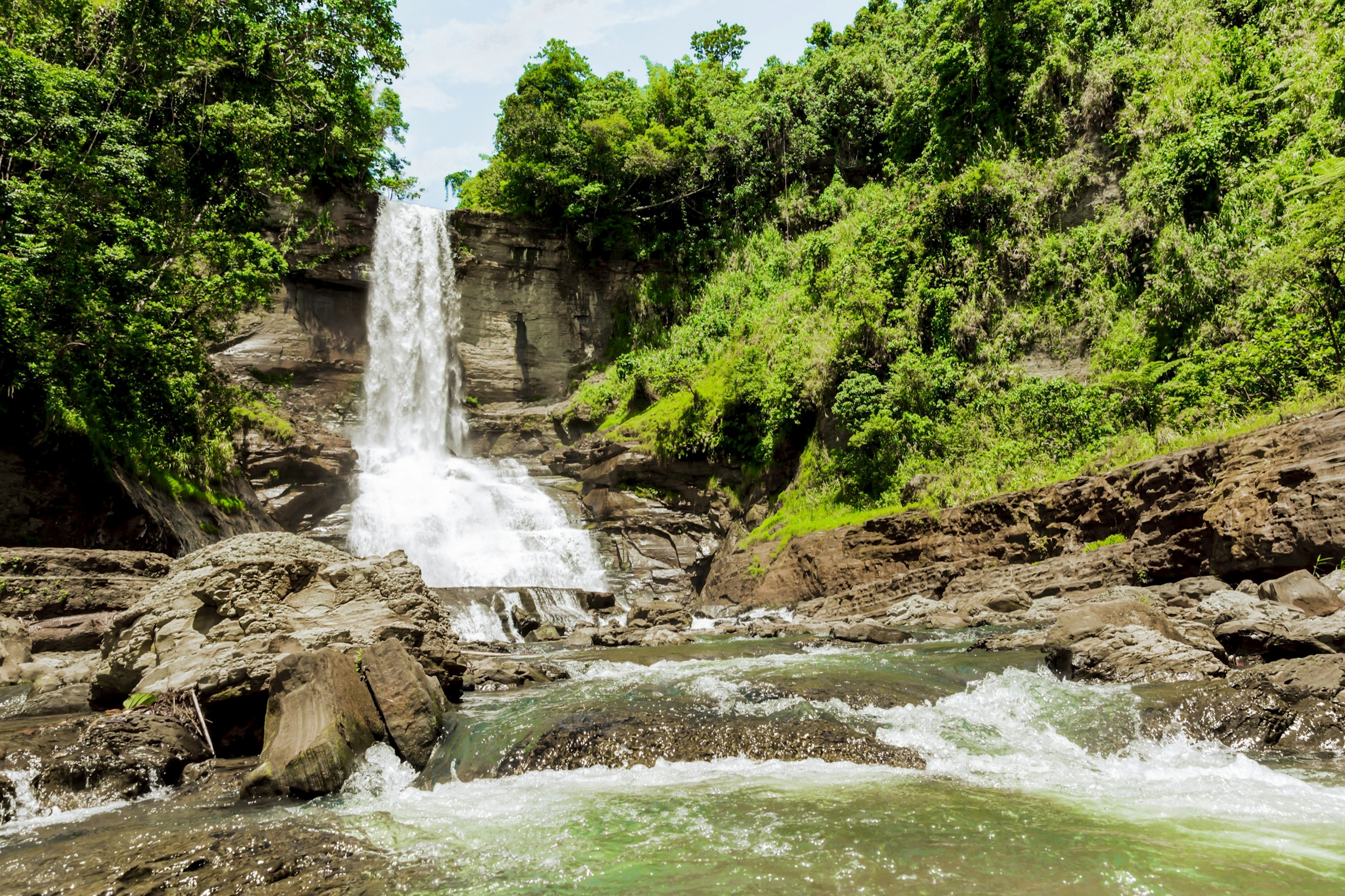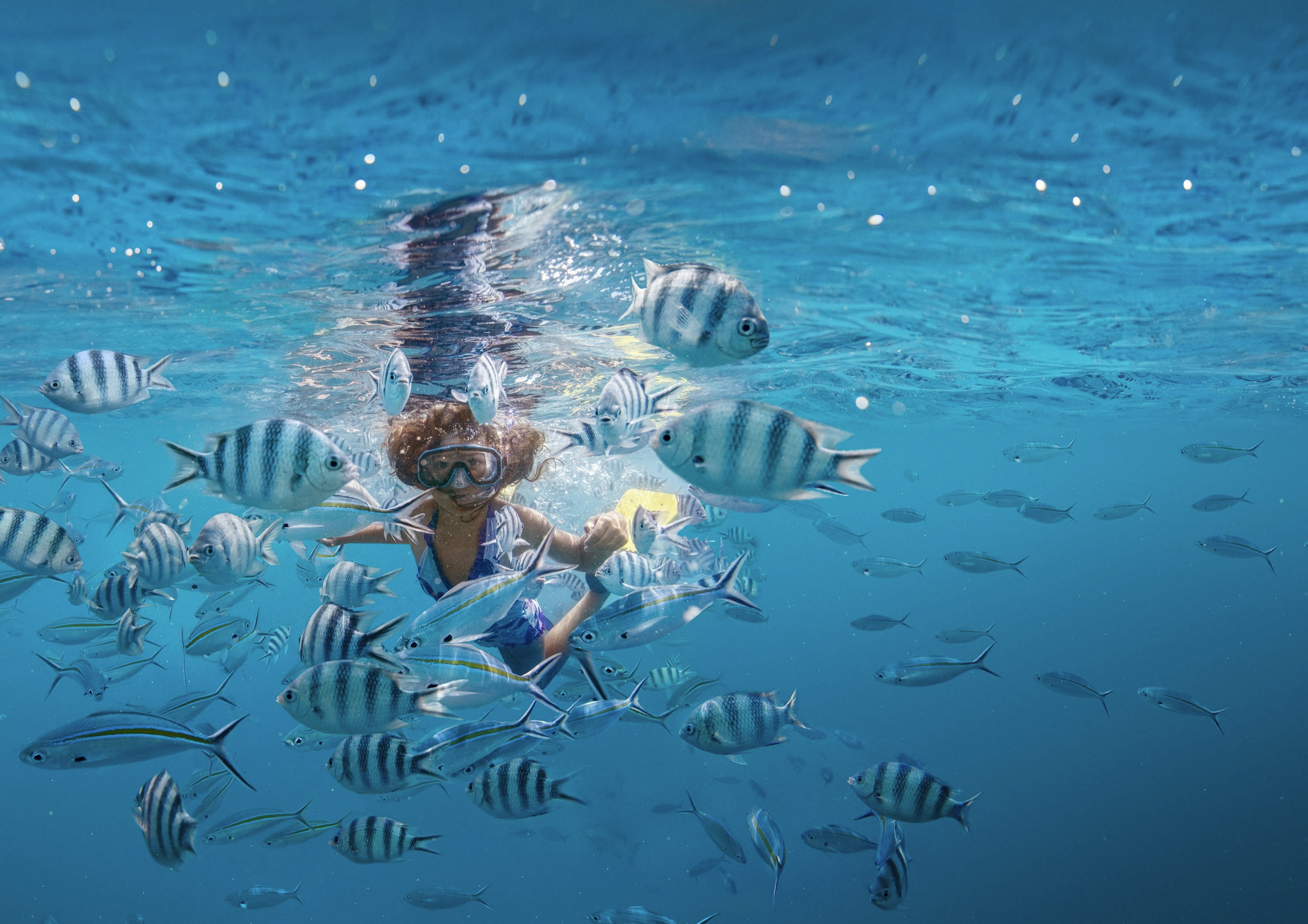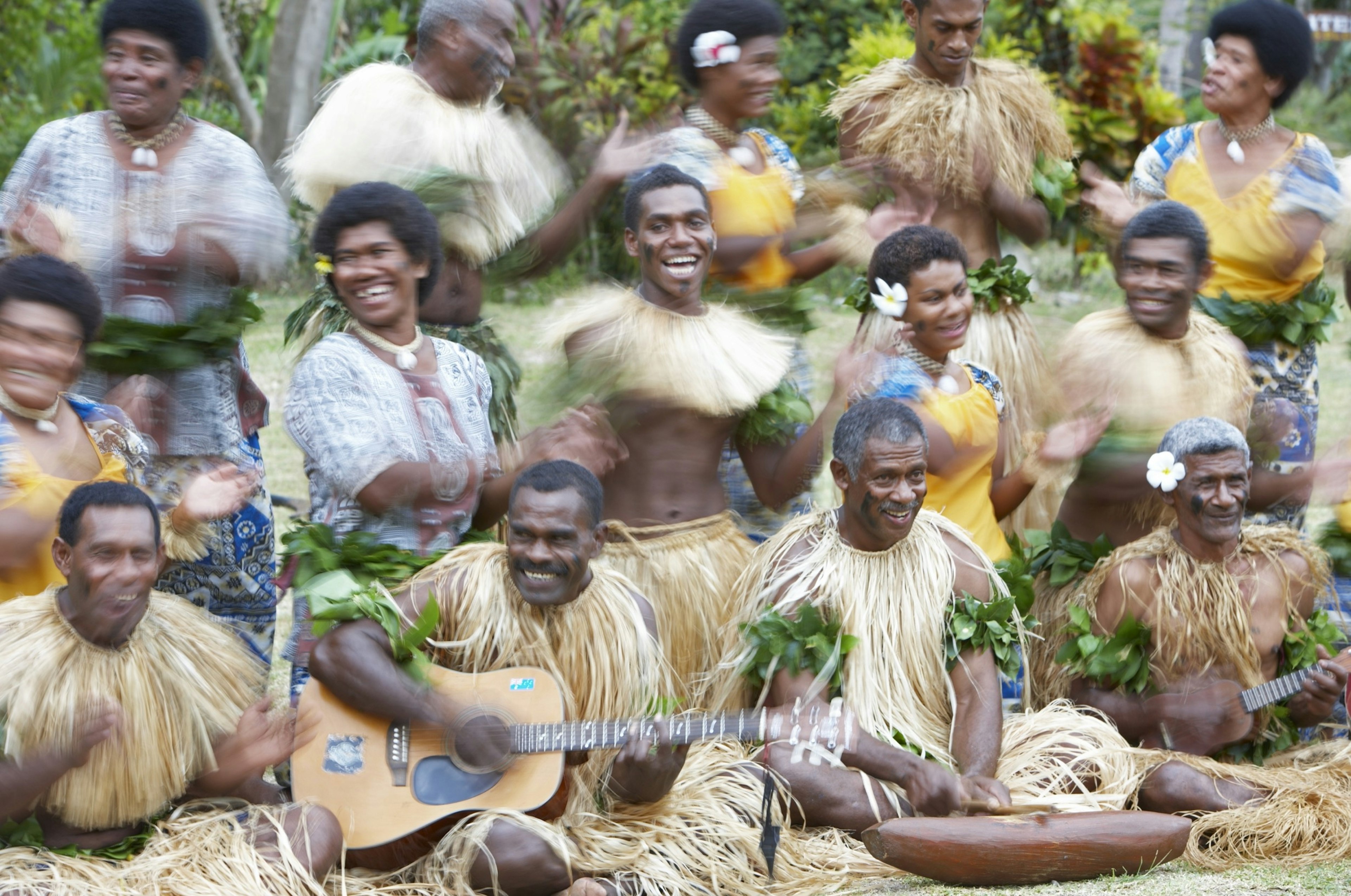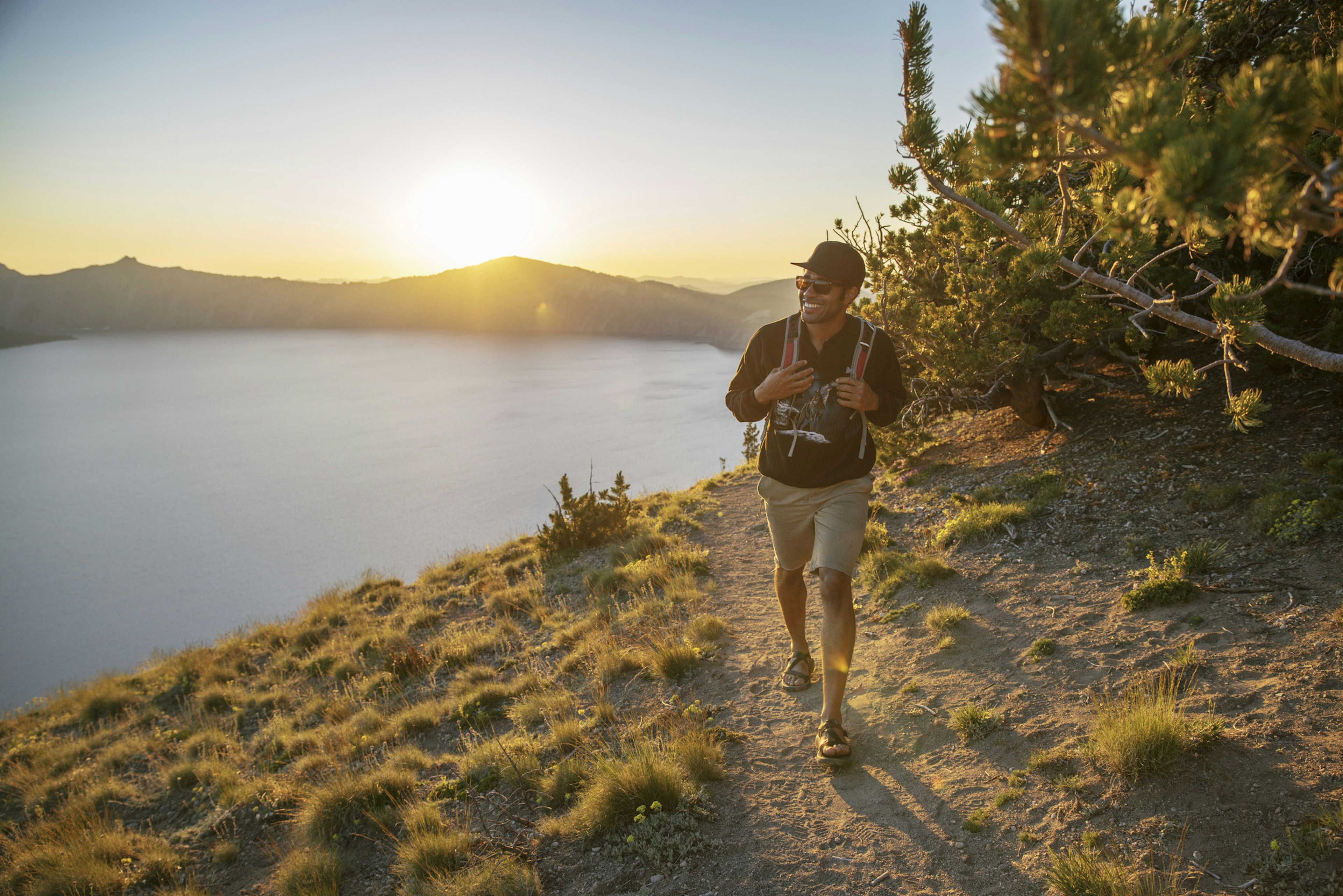La mayoría de los visitantes van a Bora Bora para disfrutar de unas vacaciones idílicas en la isla, enfocadas en relajarse en un bungalow sobre el agua en la deslumbrante laguna. Por eso, puede ser sorprendente saber que es posible sudar con una caminata intensa en esta joya de la Polinesia Francesa.
Dada su pequeña extensión y el interior montañoso cubierto de selva, realmente no necesitas aventurarte lejos para sentir que has dejado atrás la civilización en Bora Bora. ¿El beneficio de cualquier caminata sudorosa? La sorpresa de ver cuántos tonos diferentes de azul puedes observar desde tu punto de vista al mirar una de las lagunas más hermosas del mundo.
Aquí tienes siete maneras de lograrlo.
1. Cañones de Faanui
Mejor caminata corta
Menos de 300m (0.25 milla), 10 minutos, moderada
Durante la Segunda Guerra Mundial, EE.UU. seleccionó Bora Bora como una base militar estratégica de suministros y, al igual que en muchas islas del Pacífico Sur, decidió no llevarse los equipos grandes. En cuatro ubicaciones en Bora Bora, ocho enormes cañones fueron instalados en lo alto de las colinas, y aún permanecen allí. Algunos son difíciles de encontrar, pero están esperando a ser descubiertos. Si estás dispuesto a explorar un poco, es decir.
Cualquiera que encuentre los Cañones de Faanui disfrutará de vistas espectaculares de la emblemática laguna de Bora Bora como recompensa. Una vez que dejas la carretera circular de la isla, toma alrededor de 10 minutos de caminata cuesta arriba; las vistas del motu (pequeñas islas) en la laguna sirven como una distracción bienvenida de tus pantorrillas ardiendo. Al igual que la satisfacción de encontrar realmente los cañones (incluso si uno de los cañones ha desaparecido).
Los puntos de inicio de los senderos son notoriamente difíciles de encontrar en Bora Bora debido a la falta de señalización. Sin embargo, los Cañones de Faanui se pueden encontrar en Google Maps, cerca de Tereia Point en el noroeste de la isla principal. Dirigiéndote en el sentido de las agujas del reloj en la carretera circular de la isla, haz tu camino hacia la salida del ferry Pearl Beach Resort (lado de la laguna de la carretera) un poco después de Faanui. Una vez que veas la señal hacia el ferry, la pista hacia el sitio del cañón está aproximadamente 30m (98 pies) más adelante en la carretera a la derecha.

2. Cañones de Point Fitiuu
Mejor caminata para hacer picnic con vista
Aproximadamente 1.2km (¾ milla) ida y vuelta, fácil
Los excursionistas que buscan los bien conservados Cañones de Point Fitiuu – en Anau, en el lado este de la isla principal – serán recompensados con impresionantes vistas tanto del Monte Otemanu como de esa magnífica laguna (¡otra vez!). A mitad de camino de esta caminata, una curiosamente formada característica geológica sobresale dramáticamente del suelo: es comúnmente conocida como el Dedo de Hiro. (Algunos la describen usando otra parte de la anatomía masculina.)
Lleva un picnic y aproveche una mañana o tarde, usando los sencillos bancos en los cañones. Mientras disfrutas de los bocadillos, notarás que uno de los cañones apunta al Four Seasons Resort y el otro al Monte Otemanu.
El inicio del sendero puede ser un poco complicado de encontrar. La forma más sencilla es dirigirse hacia Point Fitiuu en la carretera principal de la isla, donde pronto te encontrarás subiendo una pequeña colina al acercarte en Google Maps. En la curva cerrada del camino, las vistas del Monte Otemanu aparecerán a la vista, y verás una senda que lleva a la península. El sendero comienza detrás de un edificio de cemento en terrenos privados. Si los propietarios están presentes, tendrás que pedir permiso para cruzar su propiedad.
3. Valle de los Reyes
Mejor caminata para la historia polinesia
Alrededor de 3 horas, fácil a moderada
Se dice que el gigante árbol de baniano que verás en esta caminata fue la inspiración para el “Árbol de las Almas” en la exitosa película Avatar. Ya sea verdad o no, no hay duda de que el árbol tiene gran significado cultural, ya que se dice que sirve como el lugar de descanso final de los antiguos reyes de Bora Bora.
La caminata del Valle de los Reyes es mejor realizarla con un guía – no solo porque las caminatas en Bora Bora rara vez están señalizadas, sino porque este sendero en particular pasa por reliquias de la historia temprana de la isla. Los excursionistas pueden explorar restos de antiguas aldeas y marae (templos polinesios), que solo los guías expertos podrán identificar.
También puedes disfrutar de oportunidades para comer los frutos de la isla directamente del árbol – y, por supuesto, disfrutar de esas vistas icónicas de la laguna azul turquesa.

4. Mt Otemanu
Most rewarding trek for boasting privileges
Around 6 hours total, arduous
Can Mt Otemanu be ascended? Such curiosity arises when adventurers behold this rugged summit. It towers as Bora Bora’s peak landmark—both geographically and within tourists’ imaginations—featured on every wanderlust-inducing cover and influencer’s gallery, holding a place among the renowned natural wonders of French Polynesia. Who could resist the desire to claim victory over it?
Climbers cannot attain the absolute acme of the mountain’s 727m (2385ft) highest point due to the precipitous, crumbly nature of its twin summits. Nevertheless, the exertion required to approach the mountain’s “shoulders,” includes scaling several segments with strategically secured ropes.
Be sure to experience the cave on Mt Otemanu’s northeastern face. Tradition holds it as a royal sepulchre of yore, offering vistas of unmatched beauty. Explorers are treated to panoramic views stretching across the vibrant azure sea towards the islands of Tahaʻa and Raʻiatea.
Although it is plausible to undertake this trek without a guide, it is not advisable due to the potential for independent hikers to encounter confusion or injury in the treacherous and unmarked terrain.
5. Farepiti Cannons
Optimal trek for a vigorous beginning and serene end
Approx 2.4km (1.5 miles) total, 20min single journey, simple to moderately challenging
Set high upon the slope above Point Pahua at the island’s western tip, these artillery pieces present mesmerizing panoramas. One cannon gazes towards the principal settlement of Vaitape and the Teavanui Pass, while its counterpart surveys the lagoon’s expanse reaching Pearl Beach Resort.
An initial segment will challenge your calves and build perspiration in the tropical warmth—yet eases after around 450m (1476ft), culminating at a plateau with splendid views of Motu Ahuna across the lagoon. The walk becomes more gentle from here on to the cannons.
The trailhead is along the main road traversing the island in a clockwise direction. Approximately 350m (1148ft) beyond a cargo dock in Farepiti, a dirt path winds its way up the hill, leading to the cannons. In transit, the murmuring of 4x4s and quad bikes ascending the narrow trail is ever-present—aiding orientation despite the noise.

6. Mt Pahia
Most scenic trek for stunning views
Around 6–8 hours total, demanding
Mt Pahia, standing as Mt Otemanu’s more diminutive sibling, reaches 658m (2159ft). As you ascend, marvelous panoramas reveal themselves, not only of Bora Bora but stretching to the vast Pacific as well. Like its sister peak, Pahia poses a challenge—but here, the peak is achievable. Due to precarious hiking conditions involving climbing, rope navigation, and traversing an unpreserved path, I recommend engaging a guide for this journey.
The pathway is located close to Hine Pearls, just below the charming Protestant church with its red spire in Vaitape. As always, asking locals for guidance when you arrive is advisable, given the absence of signs.
7. Bora Bora Loop
Most engaging trek for multi-day exploration
20 mile (32km), easy to moderate
For those with a few days available and a readiness for multi-day adventures, this 32km (20-mile) loop is absolutely enchanting. It follows the coastal road around the main island entirely, being the sole trek accessible in all weather conditions due to a paved and moderately flat surface.
What stands out in this journey is, well…everything: every breathtaking coastline, lagoon vista, community scene, and delightful eatery. Best of all? You have the autonomy to decide your nightly accommodations and daily distances.
Key advice for trekking around Bora Bora
-
When exploring Bora Bora’s interior pathways, a guide is advisable due to the absent signage, overgrown paths, and rugged landscape.
-
Avoid trekking off-road trails during or shortly after rainfall, as they become dangerously slick.
-
Most tours are limited to the dry spell from May through October.
-
The excursions to Mts Otemanu and Pahia are not advisable for fainthearted individuals. A sound level of fitness and self-awareness is required. Refrain from challenging these treks if acrophobia or vertigo afflicts you.


